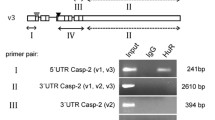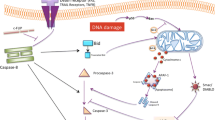Abstract
asy gene is a novel apoptosis-inducing gene, but its mechanism is unclear. To investigate the mechanism ofasy inducing apoptosis, a novel gene encoding ASY interacting protein (asyip) is isolated from human lung cell line (WI-38) cDNA library with yeast two-hybrid system. Theasyip gene is constitutively expressed as two mRNA transcripts with the size of 1.8 and 2.7 kb in various human tissues at different levels. Sequence analysis of full-length cDNA reveals that the two alternative transcripts ofasyip gene contain common 5′ end and different 3′ end, and share a common open reading frame encoding a polypeptide of 236 amino acids. Two protein kinase C phosphorylation sites and two casein kinase II phosphorylation sites are found in ASYIP amino acid sequence. Two highly hydrophobic regions encoding potentially two transmembrane domains are present. The ASYIP protein contains a C-terminal endoplasmic reticulum retrieval signal (Lys-Lys-Lys-Ala-Glu). Immunoprecipitation assay confirmed the interaction of ASY and ASYIP in mammalian cells. Compared withasy gene, overexpression ofasyip gene can inhibit growth of tumor cell Saos2 and induce cell apoptosis with a low efficiency.
Similar content being viewed by others
References
Tomislav, D., Charles, M. R., Craig, B. T., Signal transduction pathways that regulate cell survival and cell death, Oncogene, 1998, 17: 3207.
Shigeomi Shimizu, Masashi Narita, Yoshihide Tsujimoto et al., Bcl-2 family proteins regulate the release of apoptogenic cytochrome c by the mitochondrial channel VDAC, Nature, 1999, 399: 483.
Gabriel, N., Mary, A. B., Hu, Y. M. et al., Caspases: the proteases of the apoptotic pathway, Oncogene, 1998, 17: 3237.
Masato Enari, Hideki Sakahira, Hideki Yokoyama et al., A caspase-activated DNase that degrades DNA during apoptosis, and its inhibitor ICAD, Nature, 1998, 391: 43.
Hideki Sakahira, Masato Enari, Shigekazu Nagata et al., Cleavage of CAD inhibitor in CAD activation and DNA degradation during apoptosis, Nature, 1998, 391: 96.
Li, Q., Oka, K., Yoshioka, N. et al., Isolation and characterization of a novel gene ASY which efficiently induces apoptosis through a leucine zipper-mediated mechanism, in The Proceedings of the 57th Annual Meeting of the Japanese Cancer Association, Yokohama: Yokohama University Press, 1998, 148.
Field, S., Song, O., A novel genetic system to detect protein-protein interactions, Nature, 1989, 340: 245.
Sambrook, J., Fritsch, E. F., Maniatis, T. et al., Molecular Cloning: A Laboratory Mannual, 2nd ed., New York: Cold Spring Harbor Laboratory Press, 1989.
Kozak, M., An analysis of vertebrate mRNA sequences: Intimations of translational control, The Journal of Cell Biology, 1991, 115: 887.
Michael, R., Jackson, T. N., Peterson, A., Retrieval of transmembrane proteins to the endoplasmic reticulum, The Journal of Cell Biology, 1993, 121: 317.
Yuzuru Imai, Takaharu Kimura, Akira Murakamiet al., The CED-4-homologous protein FLASH is involved in Fas-mediated activation of caspase-8 during apoptosis, Nature, 1999, 398: 777.
Hsu, H. L., Xiong, J., David, V. G., The TNF receptor-1-associated protein TRADD signals cell death and NF-κ B activation, Cell, 1995, 81: 495.
Hu Jianhong, Mahito Nakanishi, QI Yipeng, Regulation of noncoding region for expression of Sendai virus hemagglutinin-neuraminidase (HN) gene, Science in China, Ser. C, 1999, 42(4): 363.
Sauvage, F., Kruys, V., Marinx, O. et al., Alternative polyadenylation of the amyloid protein precursor mRNA regulates translation, The EMBO Journal, 1992, 11(8): 3099.
Macleod, D., Charlton, J., Mullins, J. et al., Sp1 sites in the mouseAprt gene promoter are required to prevent methylation of the CpG island, Genes Development, 1994, 8:2282.
Nagata, S., Apoptosis by death factor, Cell, 1997, 88: 355.
Muzio, M., Chinnaiyan, A. M., Kischkel, F. C. et al., FLICE, a novel FADD-homologous ICE/CED-3-like protease, is recruited to the CD95(Fas/APO-1) death-inducing signaling complex, Cell, 1996, 85: 817.
Hofmann, K., Bucher, P., Tschopp, J., The CARD domain: a new apoptotic signaling motif, Trends Biochem. Sci., 1997, 22: 155.
Li Yan, Qi Yipeng, Xiao Gengfu, Structure and function ofbak gene and its apoptosis-inducing mechanism, Chinese Science Bulletin, 1999, 44(7): 605.
Author information
Authors and Affiliations
Rights and permissions
About this article
Cite this article
Qi, B., Qi, Y., Masuo, Y. et al. Isolation and characterization of a human apoptosis-inducing gene with yeast two-hybrid system. Sci. China Ser. C.-Life Sci. 43, 310–320 (2000). https://doi.org/10.1007/BF02879291
Received:
Issue Date:
DOI: https://doi.org/10.1007/BF02879291




